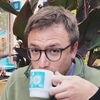So, before we go any further, let’s be straight for a second. oxio is a for-profit company and, like all for-profit companies, making a profit is one of our most important decision-making factors.
All companies need to be profitable. oxio isn’t an exception to this rule. The big telcos aren’t either.
But, and this is a big but, when a small handful of Canadian companies (aka the big telcos) make unreasonable amounts of money by providing you something that should, by today’s standards, be considered a utility at inflated prices and no one understands why the prices are what they are or why their internet bill keeps going up year after year, well, that’s what we politely call a goddamn racket. (Phew. Sorry about the rampage. But this really gets us going.)
We want to change all that. Or as much of it as we can anyways, because it just doesn’t make any sense to keep carrying on in that direction.
Most of us grew up learning that being responsible and honest was the bare minimum. We want to apply that absolute bare minimum to Canada’s telecommunications companies. And to start, we’re doing something that should have been done a long time ago: we’re explaining why our internet plans cost what they cost.
Because really, when you think about it, shouldn’t that already be the norm?
The context.
In 2019, the CRTC (the Canadian Radio-television and Telecommunications Commission) ruled that big telcos like Bell, Rogers, Videotron, Shaw, etc. must reduce the tariffs they charge independent internet service providers like us for access to their networks. This decision represented an important step towards Canadian internet plans becoming more affordable, especially considering Canada has some of the most expensive plans in the world1.
To absolutely no one's surprise, the big telcos appealed the decision as soon as it was released. Fortunately, nothing came of it, and the appeal made its way to the Supreme Court of Canada, where it was once again refused. The independent internet service providers had won. And we were pretty damn happy about it!
Buuuuuuuuuut, in a shocking twist the CRTC (yes the institution that is supposed to be on the side of Canadians) completely back tracked on their decision in the summer of 2021.
We were not happy about that.
Since the CRTC changed their mind, we’ve been stuck with network access tariffs that are even more expensive than they were before the 2019 decision. Knowing that we were going to be forced to increase the price of our plans for our future clients, we came up with our sustainable pricing model in August 2021–if we have to raise prices, we’re going to explain why.
It’s our way of educating people on how the business of internet service providers in Canada works. We want you to know and understand where your money is going and why your internet costs so, so, so, so, so much. The murky world of telecommunications has always kept Canadians in the dark. We’ve decided to do something about it.
What’s our sustainable pricing model?
To see our sustainable pricing model in all its interactive glory, click right here. Or, for now, here’s a very static but informative image for reference.

Okay, bear with us. We’re about to get all technical up in here.
Let’s start with the short version: the monthly data presented in our model are estimates of up-front costs and profits amortized over a period of 5 years. In reality, our initial activation costs vary between $315 and $350 which means we start making a profit after about 24 months.
Annnnnd the slightly longer version: when we say that we are "forced to increase our prices", it is for one and one reason only. You guessed it: the viability of oxio. Aka our profitability.
If a client is subscribed to our 30 Mbps plan for 5 years, we make a profit of approximately $210. If they stay with us for 3 years, we make a $70 profit. If they stay for 2 years, we make $0.
In oxio’s case, we aim for a return on investment of about 24 months. That means that for the first two years, we are paying back the initial activation costs for a client. In other words, any margin generated by selling our services doesn’t make oxio a single dollar during the first two years of a client’s subscription. In other, other words, a client starts being profitable after two years.
A margin is the amount of money left after we pay the network access costs every month. This margin is then used to pay for salaries, logistics, hardware, and marketing. What’s left after all that is the profit.
The network access costs are determined by the owners of the network infrastructure, which brings us back to the big telcos. Since the government heavily subsidized the construction of these infrastructures, the CRTC forces the big telcos to allow independent internet service providers to use them to ensure there is competition in the market. The CRTC also determines how much the big players can charge for access to their infrastructure. This translates into an unavoidable cost that makes up a large part of the price of our home internet plans.
If you skipped all that, the most important takeaway is that oxio makes pretty much the same profit regardless of the speed you choose. Unlike other ISPs, who we won’t name here (shame on them), we’re not interested in pushing our clients to take the most expensive plan. Or, as they like to say: “the fastest speeds of all time”. We just want as many people as possible to have access to fair and sustainably priced internet. So, choose the plan you need. It’s all the same to us.
Why are we explaining all this?
Ultimately, we're here because we believe that if everyone had equal access to the opportunities found on the internet, we’d see a lot of pretty great things from a lot of unexpected people.
And money is always an awkward topic of conversation. It can be hard to understand. Uncomfortable to talk about. Down right disagreeable even.
So when Canadians want an internet plan and their options are all more expensive than almost anywhere else in the world2, it's normal to feel taken advantage of. We want to help explain why it’s like that. Not to justify it, but to understand it so we can change it.
The oligopoly of big telcos like Bell, Rogers, Vidéotron, etc. are playing gatekeeper by actively preventing equal access to the internet. Especially as we spend more and more of our time online.
So when high prices are caused by a Commission that's a lot less objective than it should be, by big telcos who are making ridiculous profits because they’re protected by said Commission, and the telecom industry as a whole benefits from keeping us all so in the dark that we can't see the end of our nose, who wouldn’t be confused. Hell, it took six people to write this article. So, yeah it’s understandable–and infuriating–that we don’t understand how bad we have it.
The more people who are aware of the twisted nonsense that permeates the telecom industry, the more likely that is to change.
Article written by Danilo T. as well as Francis C., Marc-André C., Jérôme C.-M., Caroline D., and David P.








